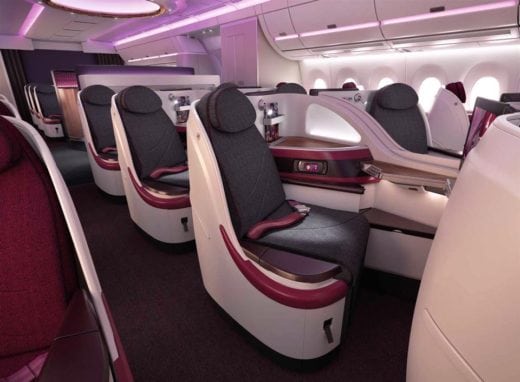
Qatar Airways cabin interior. Photo courtesy of Qatar Airways
Qatar Airways is aggressively investing in its “connected” strategy this year, according to Babar Rahman, the company’s head of global sponsorships, CSR and in-flight entertainment/connectivity (IFEC). The airline is really stepping up its plans in light of its recent broadband deal with Inmarsat.
However, Rahman believes there is still a lot of confusion among airlines about the types of solutions service providers can offer. “I think the providers have done a good job in confusing the airlines in terms of the different types of satellite capacities and solutions out there,” he said. “From our perspective, we have met every single supplier and looked at every single possibility for what would be available for us now, what would be best for us in the next five years [and] what would be best in the next 10 years.”
With technology moving so fast, he admits that the idea you can provide a certain megabit per passenger today will probably become redundant in two to three years. “We were confused in the beginning when we started meeting all the suppliers. But the approach we have taken is that we focused the requirement around our passengers. So, forget about LEO/GEO satellites and bands and everything else and just look at what the passenger requires and would require, and what is the business view to use this capacity,” he said. “Based on that, we know exactly how much capacity we need, what technology we need to implement, and we have chosen the suppliers based on that exactly.”
In terms of how much satellite capacity Qatar Airways might need, Rahman said it will be interesting to see over the next few years if the capacity projections are indeed meeting the actual demand. “Bandwidth cannot be assumed based on user devices. It will typically depend on passenger behavior and the connectivity bandwidth system,” he said.
One of the big challenges for any airline when implementing its in-flight connectivity (IFC) strategy is figuring out which business model to use. Some believe the free model will ultimately win out, but given the cost of bringing these services, many including Rahman don’t believe that it’s feasible right now. He said the free model is not realistic unless you have a partner prepared to help with those costs on the backend. He believes the investment is so massive that airlines can’t provide this for free, and that it would not be sustainable in the long run.
“Even if you look in this part of the world, where some airlines initially gave it for free or almost free, that model has now changed. We changed our model last year; we are increasing our revenue and we won’t go down the path of providing free Wi-Fi,” he said. “You have to look at the partnership model; we have partnered with Ooredoo and, as such, at the moment are not proactively seeking new partners at this stage.”
Continue reading the full article on Avionics’ sister publication Via Satellite.